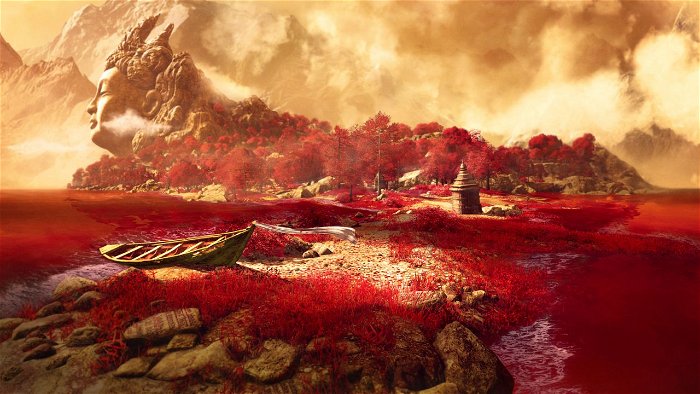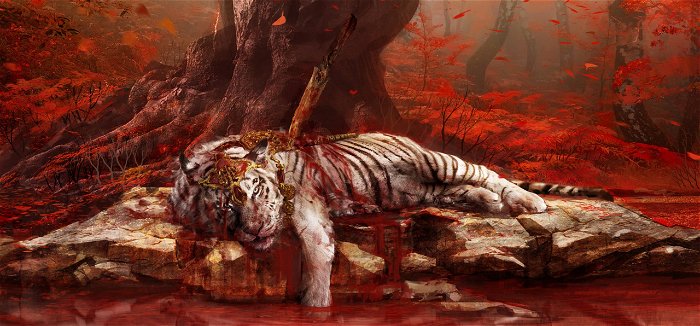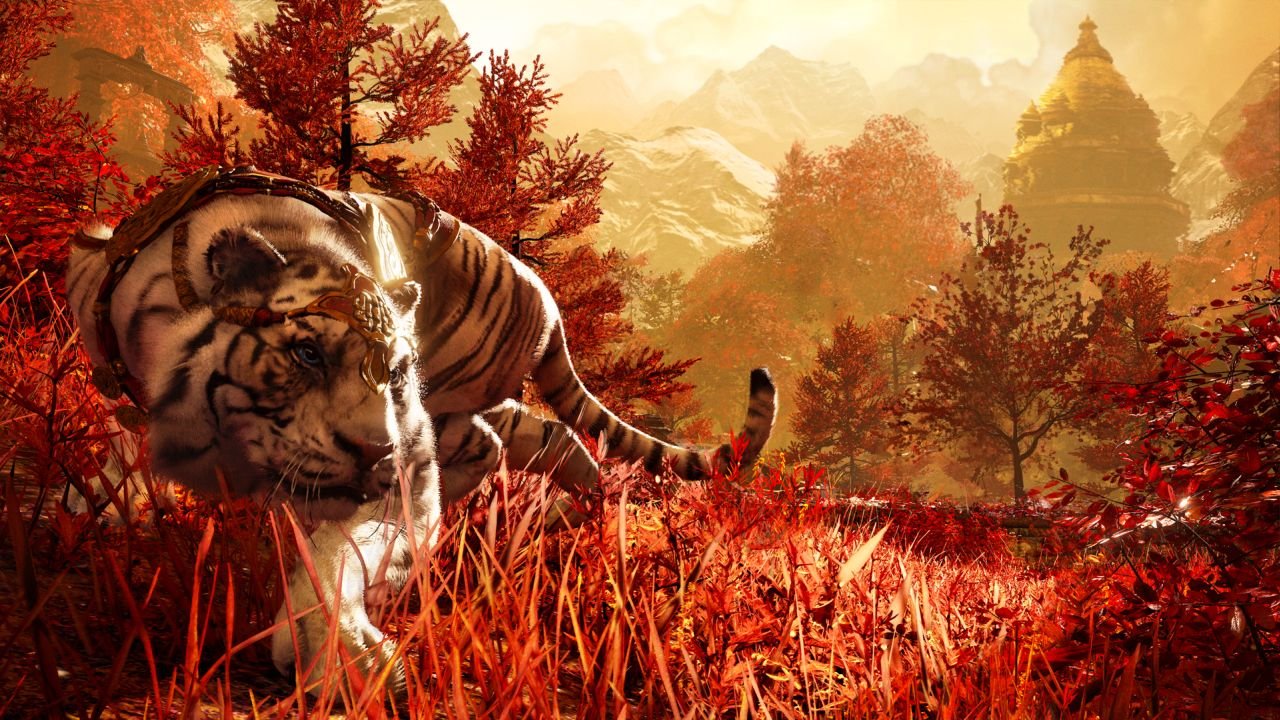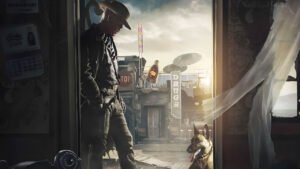Ubisoft have been doing some unique things for the Far Cry franchise. Starting from a story about an island, the game has evolved into a crazy exploration of humanity and culture. With the latest installment we are transported to the Himalayas where the player must clash with a despot in an insane, violent battle. Ubisoft did not end there though; they pushed to have a section of the game that goes even further that breaks all rules of reality.
The Shangri-La section of Far Cry 4, transports players to a mythical land where they, with the help of a magical tiger, must decide the outcome of a legend . Seemingly removed from all limitations of normalcy , Shangri-La even throws away the realism of the main game for a more vibrant art style that helps paint a magical world. We where lucky enough to get to sit down with Matt West, the Level Design Director Shangri-La, and got to ask him some more details on what players should expect from the Shangri-La section of the game.

Comics Gaming Magazine: Can you explain what Shangri-La is and what players can expect from playing Shangri-La?
Matt West: Shangri-La is the mythology of the world of Kyrat. So when Ubisoft Toronto joined the Far Cry 4 project we wanted to find a way to fit into the world of Kyrat that the team in Montreal had created, but without getting in it’s way, without trampling on it. And we looked at it and we realized that they’ve created a living, breathing, not only world, but people who inhabit the world, and that this culture is very, very old. One of the things that older cultures have is they all have heroes, they all have mythologies, they have their legends; so that is kind of where Shangri-La was born out of. It is the story of and ancient Kyrati warrior named Kalinag, sent by his king to discover the world of Shangri-La, and the player is going to have the opportunity to tell us what that legend is because we are going to drop them into the action and let them decide how they are going to play and what they are going to do.
So really what is unique about it is that, even though it is appearing inside of a Far Cry game, it is distinctly different in one primary way, which is there are no guns in Shangri-La. The player has two weapons. One is a bow, and the bow mechanics are similar to what the players will see in the world of Kyrat, but there is always a twist in Shangri-La. So the bow in Shangri-La can actually slow down time. The other advantage that you have, the other tool, we call him the protector. He is the protector of Shangri-La and he is a 600 pound tiger. So the player allies himself with the tiger and then the two of them work together to fight back against the demons that are trying to invade and usurp Shangri-La.

CGM: And how will this affect the main game or is it a separate experience that will just take place on the side?
MW: It’s actually in between those two points. I don’t want to go too much into the story in the main game, but there are connections between the world of Shangri-La and the world of Kyrat. The player experiences it by exploring the open world of Kyrat. The story of Kalinag was actually rendered out onto a big thangka [pronounced tonka], which you can think of as a big tapestry. The thangka was torn into five pieces and spread throughout the world. So by exploring the open world, you know you’re flying down a mountain face and you see a cave you haven’t seen before. You grapple down to the bottom of the cave, you find a piece of this thangka, in our minds you meditate on it, and then you become Kalinag, thousands of years ago inside Shangri-La.
CGM: So none of the weapons from the main game transfer in?
MW: That’s right. You have the bow and the tiger, and then you have the ability, as you do in Kyrat, to look around the environment. We have that in common with Kyrat, that there are opportunities to use the environment to advance your cause, but that is where the gameplay similarities end. We have a bow that slows down time and a tiger that rips people to shreds [laughs] so it’s very different.
CGM: Is it a large section of the game or is it a very sectioned off and small part of the game?
MW: That’s a tough question to answer. As I said there are five experiences of Shangri-La and I can tell you very honestly we’ve had people play a mission fairly quickly, like 20 minutes, and we’ve had people play over an hour. I always liken it to the first time you find yourself in a new city; you pull out your camera and spin three-sixty. Shangri-La looks very different from the world of Kyrat and that is primarily what is feeding that longer playtime. People really are tourists; they are very inquisitive about this new world.

CGM: How did you come to that visual design compared to the main game?
MW: I think it was a lot of experimentation on the part of the art director. We wanted to find something that was unique and iconic that would work with the gameplay differences. Shangri-La has gameplay differences from Kyrat so we also wanted it to have an artistic difference as well. But really the look was born out of the main idea, or what we think of as the narrative logic. Everything is red because in our mythology that we’ve created, the goddess Kyra, and that is where the name Kyrat comes from, came to Shangri-La to meditate and achieve nirvana. It was taking a long time and out of frustration she spun the wheel very quickly, pricked her finger, and her blood flowed down into the world, flowed into the ocean, and once it’s in the water it’s everywhere. So that’s why the world of Shangri-La is so red.
CGM: Did you take any inspiration from any real world concepts to create the world?

MW: Quite a bit actually. One of the steps we took after we decided on mythology was to look at the mythology of the Himalayas region. So we looked at mythology from Tibet and Nepal and Bhutan and started to pick out some common thematic elements. Once we had that list of elements that were common we built our mythology from that point. So they are very much inspired by the mythology of the region, but we took a right turn from that and created something that is uniquely our own.
CGM: When people are first getting into the world of Shangri-La, is it something they should be looking for or is it just something they need to experience for themselves?
MW: I think it is the kind of experience that everyone will play differently. We do a very good job of making it available, but as is the standard in Far Cry, we don’t ram it down your throat. It’s for the player to experience; it is for the player to take the decision to jump in. I am 100 percent confident that when they jump in once, they are going to want to come back.
CGM: So it isn’t a mandatory part of the game?
MW: That is correct. It is not mandatory, it is based out of exploration. I don’t want to give too much away but I will say there are a number of incentives for playing Shangri-La that I feel will pull it back and the biggest one is that Shangri-La is super cool, people are going to have a good time.




